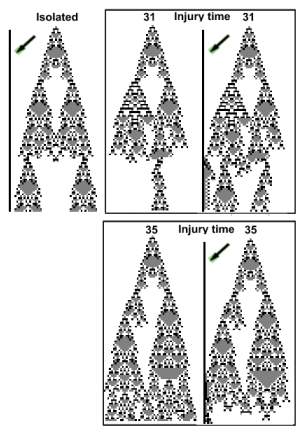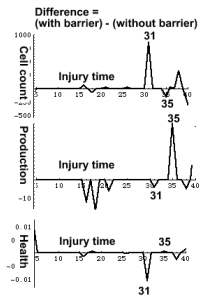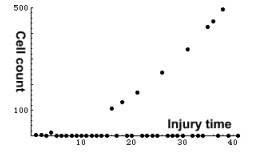 |
How to convince a CA to budge?
The experiment starts with planting a zygote
near a barrier (Isolated CA) The barrier is marked by an arrow. As it
grew the CA broadened but did not reach the barrier. Next, the CA was
injured at rising times. Finally, the same treatment was applied to a
CA which grew next to the barrier. A similar interaction between CA and
a barrier was described before. Following injury
some CA became broader and other shrunk. Two CA which became broader are
depicted below. The left one grew isolated, and the right one grew next
to a barrier.
 |
The difference between three parameters, Cell count, production and health, are depicted (Compare with the previous experiment). Any deviation from zero indicates that CA touched the barrier and interacted with it. At t =31, CA became bigger and produced less. At t = 35, CA shrunk and produced more cells.
 |
In order to become wider, the CA had to grow and invest new resources, like cells. The last graph depicts, the size of the CA (= cell count) upon touching the barrier. As time passes it has to grow more and more until touching the barrier.
 |
The result of the interaction between CA and barrier, is either positive, when CA grows (t = 31), or negative,
when it shrinks ( t = 35). The experiment simulates the behavior of
an ameba approaching an
obstacle. It is driven by hunger, which might result from an injury
to its cytoplasm, driving the ameba to seek food. The longer
its hunger the more resources have to be diverted to the search.
The experiment demonstrates how life interacts creatively with matter.
It covers the barrier with cells and uses it as an exoskeleton.
WOB computer
input = {injury, barrier} output = {Cell count, production, health}
Set up
injury range=1; injury1=4; injurytime = *; barrier = 25; barriercolor
= 2; effect[1,1, 1.7, sa[[1]]]